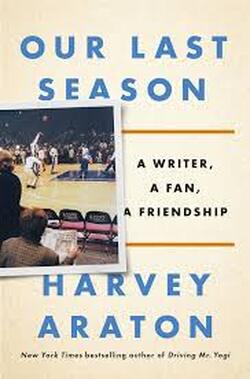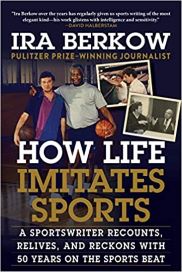 Not too long ago, Harvey Araton and Ira Berkow were gracing the sports pages of The New York Times with their wise columns. Now they are both issuing books with their very personal views of the world. Harvey’s book is “Our Last Season: A Writer, a Fan, a Friendship,” about the bond between him and Michelle Musler, who for decades was a fixture in the stands just behind the Knicks bench in Madison Square Garden. Ira’s book is “How Life Imitates Sports: A Sportswriter Recounts, Relives and Reckons With 50 Years on the Sports Beat,” which just about tells it all. (In alphabetical order) Araton praises the wise businesswoman who was always there – for the Knicks and for him. He describes himself as the child of a project in Staten Island, who earns his entry into sports journalism while battling his own insecurities. As he works his way from the Staten Island Advance to the Post to the Daily News, his talent and earnestness impress not only editors and readers but also a fan literally looking over his shoulder in the Garden. Musler saw all – could read the body language, maybe even read lips, of the Knicks and the opponents and the refs. She had put her people skills to great advantage in the corporate world, undoubtedly by being wiser than the average (male) executive. The Knicks were her outlet, she freely told friends, her social life. Everybody knew her – the players, nearby fans, reporters, ushers, even the team PR man, who left a packet of media stats and releases for her before every game. How cool was that? Musler more or less adopted Harvey, counseled him, shaped him up, told him to aim big. She became friendly with Harvey’s wife, Beth Albert, and sometimes met Harvey after a game to debrief him on what she had seen from her perch. When he fretted whether he was worthy of the Times job being offered, she figuratively slammed him up against a steel locker and gave him what a high-school coach I knew called “a posture exercise.” And when his career took a sour detour, she shaped him up, to the point that in retirement he remains an extremely valuable contributor to the Times sports section. Harvey is still what somebody once called him: “The Rebbe of Roundball.” In return, Harvey came to know Michelle Musler – her strange childhood, her husband leaving her with five children, her career, her need to make money, her love of the Knicks. Her decades of working with male executives prepared her for a searing analysis of James Dolan, the miserable owner of the Knicks. As Michelle’s health deteriorated, Harvey would sometimes drive from New Jersey to Connecticut to the Garden to get her to a game. And when Michelle Musler passed in 2018, Harvey wrote a beautiful obit for the Times: https://www.nytimes.com/2018/07/05/obituaries/michelle-musler-courtside-perennial-in-the-garden-dies-at-81.html  Ira Berkow’s book is also personal – about a talented, ambitious kid from Chicago who made his way to New York and became a fixture in the Times and also in books, not all about sports. Ira has touched on most stars of the past half century – Muhammad Ali! Michael Jordan! He sized up O.J. Simpson, before and after! He had lunch with Katarina Witt! He shot baskets with Martina Navratilova! He also shot baskets with a retired Oscar Robertson! He schmoozed with Abel Kiviat, then America’s oldest living medalist! And he scrutinized a brash real-estate hustler named Donald Trump! One of my favorite segments is about Jackie Robinson – who broke baseball’s disgraceful color barrier in 1947. Ira recalls being 15, a high-school athlete himself, watching the Dodgers take on the Yankees in the 1955 World Series. In 2018, with JR42 long gone, Ira was being interviewed on TV about Robinson and came up with a description of how Jackie Robinson had faked the Yankees’ Elston Howard -- a catcher playing left field -- into throwing the ball to second base while Robinson steamed into third. Later, he remembered interviewing Robinson in 1968 about his thought processes in testing Howard, who was out of position because Yogi Berra was the catcher. Robinson seemed to deflect Ira’s analysis, but the audacious move remained in Ira’s fertile brain. A few years ago, Ira looked it up in the official play-by-play for the 1955 Series: it confirmed that Robinson, by whatever logic, had victimized Howard into throwing behind Robinson. This section confirms the instinctive genius of Jackie Robinson and also the enlightened journalistic observation powers of Ira Berkow. * * * Most of sports have been thrown off balance by the pandemic, but these very different books by Harvey Araton and Ira Berkow remind us how great sportswriters have enriched us by writing about the world, on and off the court. 10/27/2020 03:32:59 pm
A wonderful tribute to two great writers.
George
10/27/2020 05:22:44 pm
Alan: you both would have enjoyed meeting Michele.
bruce
10/28/2020 12:03:57 am
george,
GV
10/28/2020 03:24:12 pm
Bruce: You're right...Harvey often had an edge -- in the direction of social justice or just rational management of the Knicks. He came out of the city school, knew NY basketball, and its coaches and characters. The NYT had more of a NY edge, and he was fun to read for that.
bruce
10/28/2020 05:01:56 pm
george,
ED MARTIN
11/1/2020 11:10:37 am
Thanks GV. Once, again, an example of what makes you “one off.”
George Vecsey
11/2/2020 09:15:47 am
Ed: I'm off. Not so sure about "one off." Thanks.
bruce
11/2/2020 09:45:46 am
george,
Ed
11/2/2020 01:18:08 pm
Bruce reminds me, I believe you know this. My first real job, if you dont count caddying, and setting pins and mowing lawns without power, was signing up people for 13 week subscriptions to the Nassau Daily Review Star. I was recruited on the street by Roy Hepp, circulation salesman for Newsday. As Levittown, East Meadow, Uniondale and more were being built and sold daily, I prospered, causing my Dad to lose his income tax deduction.
bruce
11/2/2020 02:15:12 pm
ed, Comments are closed.
|
Categories
All
|









